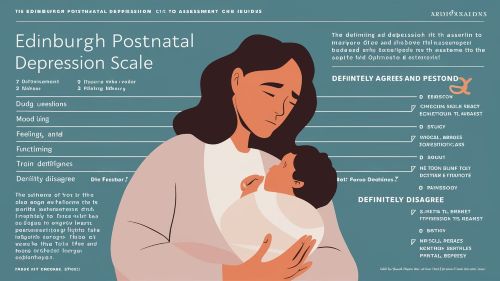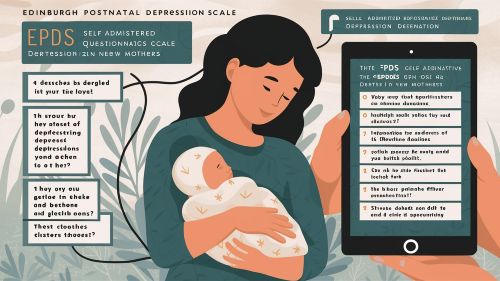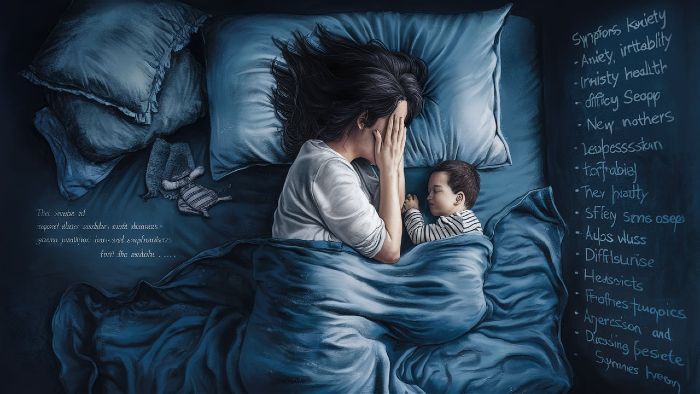The casseroles have stopped coming. The constant stream of visitors has trickled to a halt. Your baby is no longer a fragile newborn; they are sitting up, crawling, maybe even taking their first steps. By all societal standards, the “postpartum” period is over. You should be back to normal.
But you’re not.
The deep, persistent sadness hasn’t lifted. The joy you see other mothers experiencing feels like a foreign language. You’re irritable, exhausted in a way that sleep never seems to touch, and you feel like a ghost in your own life.
A voice in your head, echoing the unspoken expectations of the world, whispers, “It can’t be postpartum depression. It’s been too long.”
This article is here to silence that voice. Postpartum depression doesn’t watch the clock. It doesn’t magically disappear at the 6-week checkup or your baby’s first birthday. Its symptoms can linger, evolve, and sometimes even appear for the first time, long after the newborn phase is a distant memory.
It’s time to shed light on the long tail of PPD and validate the struggles of mothers who are well beyond the “fourth trimester.” Your experience is real, and it has a name.
The Myth of the Postpartum Expiration Date
Our society has an unofficial timeline for new motherhood. The first few weeks are for survival. By three months, you should be “getting the hang of it.” By six months, you should be a pro. And by a year, you should be fully “bounced back.”
This narrative is not only unrealistic; it’s dangerous. It creates a wall of shame for mothers who are still struggling.
Let’s be clear on the clinical definition. According to the American College of Obstetricians and Gynecologists (ACOG), Postpartum Depression can be diagnosed if it occurs anytime within the first 12 months after childbirth.
Key Takeaway: PPD Does Not Have an Expiration Date
Many mothers experience symptoms that last well beyond a year, especially if their PPD was untreated or inadequately treated. This is often called persistent postpartum depression. Your struggle is not less valid because your baby is no longer a newborn. In fact, the challenges of parenting an older baby or toddler can sometimes make the symptoms even more pronounced.
The Subtle (and Not-So-Subtle) Symptoms of Lingering PPD
While the core symptoms of PPD—sadness, anxiety, loss of pleasure—remain, the way they manifest can change as your child grows. Here are some of the common signs of PPD in mothers of older babies (6-12+ months).
[Use the “Columns” block to arrange the following sections in a visually appealing way.]
The Cognitive Fog: Your Brain Feels “Broken”

In the early days, you might have chalked it up to “mom brain.” But months later, it feels different—deeper and more debilitating.
- Difficulty Concentrating: You can’t finish a book, a movie, or even a conversation. If you’ve returned to work, you may find yourself staring at your screen, unable to focus on tasks that used to be easy.
- Memory Problems: You forget appointments, lose your train of thought mid-sentence, and struggle to recall simple words.
- Decision Paralysis: Even small choices, like what to make for dinner or what to buy at the grocery store, feel monumental and overwhelming.
The Emotional Static: It’s More Than Just Sadness
The constant, weeping sadness of the early weeks might have subsided, replaced by a more chronic, low-grade emotional state.
- Pervasive Anhedonia (Numbness): This is a big one. You don’t feel intense sadness, but you also don’t feel… anything. The world seems muted. You go through the motions of playing with your baby, but you feel a profound sense of detachment, like you’re watching a movie of someone else’s life.
- Postpartum Rage and Irritability: As your baby becomes a mobile, boundary-pushing toddler, the underlying anxiety and overwhelm of PPD can explode as anger. You might find yourself snapping at your partner, yelling in a way that scares you, or feeling a constant, simmering rage just under the surface.
- A Constant Hum of Anxiety: The fears may have shifted from SIDS to a new set of worries: “What if they choke on this solid food?” “What if they fall down the stairs?” The anxiety feels constant and disproportionate to the actual risk.
The Behavioral Retreat: The Slow Fade from Your Own Life
This is how lingering PPD shows up in your actions.
- Deepening Social Isolation: You actively avoid social gatherings, even with close friends. The effort of putting on a “happy face” is too exhausting. Playdates feel like a performance you can’t endure.
- Loss of Identity: You look in the mirror and don’t recognize the person staring back. You’ve lost touch with the hobbies, passions, and parts of your personality that defined you before motherhood. You don’t feel like a “mom,” but you don’t feel like your old self, either.
- Marital or Relationship Strain: The disconnect you feel extends to your partner. You may feel resentful, emotionally distant, and have a complete loss of libido. The strain of long-term untreated PPD can push a relationship to its breaking point.
A Story of a Mom at 10 Months
“My son, Leo, was 10 months old. He was happy, healthy, and meeting all his milestones. I, on the other hand, was a shell. I loved him, I knew that intellectually, but I felt nothing. My days were a monotonous loop of feeding, playing, and cleaning, all performed with a deep, hollow feeling in my chest. My husband would ask what was wrong, and I’d just say, ‘I’m tired.’ How could I explain that I felt so empty when my life was so full? I thought, ‘It can’t be postpartum depression. That’s for new moms.’ I finally broke down during Leo’s one-year checkup when the pediatrician gently asked how I was doing. Admitting I wasn’t okay at 12 months postpartum was the hardest and best thing I ever did.”
Why Does PPD Linger or Appear So Late?
If PPD is triggered by the hormonal crash after birth, why would it still be a problem at 9 or 12 months? There are several key reasons.
- Untreated or Undertreated PPD: This is the most common reason. If PPD isn’t treated early, the negative thought patterns and brain chemistry changes become more entrenched, like a path in a forest that gets deeper with every use. It doesn’t just go away; it settles in for the long haul.
- The Stress of New Milestones: The postpartum year is not one event; it’s a series of new, stressful transitions.
- Returning to Work: The logistical and emotional stress of juggling a career and motherhood can be a massive trigger.
- Weaning: The hormonal shifts that occur during weaning from breastfeeding can trigger or exacerbate depression.
- Sleep Regressions: Just when you think you might get some rest, your baby’s sleep patterns change, plunging you back into severe sleep deprivation.
- The “Village” Disappears: In the first few weeks, there might be a flurry of support. By six months, that support has often vanished. You are left more alone than ever, at a time when your baby is becoming more mobile and demanding.
- The Accumulation of Sleep Debt: Chronic, long-term sleep deprivation has a corrosive effect on mental health. It’s not a single event, but a debt that gets larger and larger over time, making you more vulnerable to depression.
It Is Never, Ever Too Late to Get Help
If you are reading this and seeing yourself in these words, please hear this: It is not too late. Hope does not have an expiration date. Treatment for PPD is effective whether you seek it at 6 weeks, 6 months, or even 6 years postpartum.
Your First Steps:
- Validate Yourself: Acknowledge that your struggle is real. Give it a name: Persistent Postpartum Depression.
- Talk to a Doctor: Make an appointment with your GP or OB-GYN. Be explicit. Say, “I am still having symptoms of postpartum depression, even though my baby is now [X] months old.”
- Seek a Specialist: Ask for a referral to a therapist or psychiatrist who specializes in perinatal mental health. They understand the nuances of later-stage PPD.
- Re-evaluate Your Current Treatment: If you have been in treatment but still feel unwell, it may be time to discuss a change in medication, a different therapeutic approach, or adding a new layer of support.

Frequently Asked Questions (FAQ)
Q1: Can I develop PPD for the first time at 9 months postpartum?
Yes. While less common than onset in the first three months, “late-onset PPD” is absolutely real. It is often triggered by a major stressor like weaning, returning to work, or a lack of support catching up with you.
Q2: How do I know if it’s PPD or just parental burnout?
There is significant overlap. The key difference often lies in anhedonia and hopelessness. Burnout feels like, “I am exhausted by my circumstances.” PPD feels like, “I am fundamentally broken, and my circumstances will never get better.” PPD carries a heavy weight of self-blame and worthlessness that is less prominent in burnout.
Q3: My doctor dismissed my concerns because my baby is older. What should I do?
You have the right to a second opinion. Not all healthcare providers are equally trained in the nuances of perinatal mental health. Seek out a different doctor or go directly to a mental health professional who specializes in this area. You are your own best advocate.
You Are Not an Afterthought
Your well-being did not cease to matter when your baby stopped being a newborn. The struggles you face at nine, twelve, or eighteen months postpartum are just as valid as the ones you faced at six weeks.
You are not an afterthought in your own story. The long tail of postpartum depression is real, but so is the path to recovery. It’s never too late to take that first step.
Disclaimer: This article is for informational purposes only and does not constitute medical advice. If you are struggling with symptoms of depression, please contact a healthcare provider, a mental health professional, or a crisis hotline immediately.
